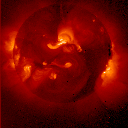





The Sun Now | Compare to Active Sun |
|---|---|
 |  |
Image Credit: The solar x-ray images are from the Yohkoh mission of ISAS, Japan. The x-ray telescope was prepared by the Lockheed Palo Alto Research Laboratory, the National Astronomical Observatory of Japan, and the University of Tokyo with the support of NASA and ISAS. | |
| What layer does the light come from? | |
About the images:The surface of the sun, at 5800 degrees Kelvin, is too cool to produce soft xrays. This being the case, the sun should appear black in soft xray images. To produce the bright regions seen in the images above, gases in the corona of the sun must be heated to temperatures in excess of 2 million degrees Kelvin. The xrays are not produced by changes in the excited states of atoms. Atoms are broken apart into electrons and ions at the high temperatures in the corona. When a high speed electron passes near an ion, they interact through their electric charges (ions are positively charged, electrons are negatively charged). The heavy ion isn't deflected much from its original path. However, the electron changes its direction and speed dramatically emitting radiation both at radio and xray wavelengths. This radiation is called bremsstrahlung or "braking" radiation. The brightest regions in the photos above are seen over sunspot groups in active regions and at flare sites. In these regions, electrons accelerated to high speeds by electric fields, crash violently into the denser material of the chromosphere and rapidly decelerate producing intense bursts of xrays. We cannot see these bright spots from the surface of the Earth because soft xrays cannot penetrate through the protective layer of our atmosphere. These pictures were taken by the Yokhoh spacecraft in orbit around the Earth. |
|
What to look for:Features of the corona in soft xrays include: dark coronal holes, bright torch-like active regions, short-lived bright points, and immense magnetic arches. Below is a movie of the sun constructed of images taken in soft xrays by Yokhoh over a 30 day period . With north oriented upward, features move across the solar disk from left to right as the Sun rotates. The Sun does not rotate as a solid body but features at the equator move across faster than those at the poles. |
|
Connect me to the SOHO image gallery and the SOHO Movie Theater
Connect me to the Yokhoh Movie Theater
The source of this material is Windows to the Universe, at http://windows2universe.org/ from the National Earth Science Teachers Association (NESTA). The Website was developed in part with the support of UCAR and NCAR, where it resided from 2000 - 2010. © 2010 National Earth Science Teachers Association. Windows to the Universe® is a registered trademark of NESTA. All Rights Reserved. Site policies and disclaimer.